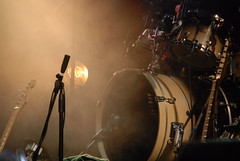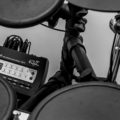The tenor drum is one of the many drums used by American marching bands. Although it is now most commonly seen in parades and on sports fields during halftime shows, this instrument has been used since the mid-19th century by a variety of composers. It is a lower-pitched version of the snare drum, another staple of marching bands. On the field, the tenor drum is easily recognizable, as it is typically carried in mounted sets of three to six drums. This arrangement allows the musician to play multiple drums simultaneously, contributing to the richness of the percussion.
Tenor drums are played with a wide range of implements, all of which are a type of mallet or drumstick. The heads of these beaters can be made from various materials, including wood, plastic, nylon, felt, rubber, or fleece. The drumheads of tenor drums are as tight as possible, producing a relatively high-pitched sound that is highly effective in outdoor settings.
As mentioned, tenor drums are carried and played in sets. The name of the set usually refers to the number of drums it contains; a “quad,” for example, consists of four drums. Each drum in a set has a different diameter and, therefore, produces a different pitch of sound. Both the loudness and the range of the tenor drum make it a valuable addition to marching bands. A band may have as many as six tenor drum players, each carrying up to six drums, resulting in a total of thirty-six instruments. Tenor drums are used to accent snare drums, but they also add melodic percussion.
A set of four tenor drums is typically arranged so that the lowest drum is on the player’s far left, the next lowest on their far right, the second highest on their center left, and the highest on their center right. When a tenor drum is played, it is struck near the edge of the head. This technique allows the drum to project maximum resonance and tone. As for the method governing the transition from one drum to the next, there are two main systems. The more common one involves allowing the drumsticks to move across the drums in a straight line. This style reduces the amount of space the player needs to cover, thus speeding up their performance. The alternative system, called the “arc” system, requires the player to follow an arc from one drum to the next. The arc system was more common in the early days of the tenor drum and is rarely used today.
The use of tenor drums in marching bands can likely be traced back to their traditional use in military drum corps. In these contexts, the instruments are used for both timekeeping and musical purposes. In a military drum corps, three types of tenor drums are used: the flourishing tenor, characterized by the player’s dramatic drumstick movements; the alto tenor, played in tandem with the bass drum; and the rhythm tenor, used to accentuate the snare drum part.
Manuel Marino is a seasoned Senior Producer, Music Composer, and Artist with over a decade of experience. He specializes in branded entertainment across various mediums, including video games, films, and advertising campaigns. With 20+ years as a game music composer, Manuel has worked on numerous platforms, creating diverse orchestral soundtracks. HIRE ME


 Manuel is a passionate, driven, and techsavvy AV technician,
Manuel is a passionate, driven, and techsavvy AV technician, 





